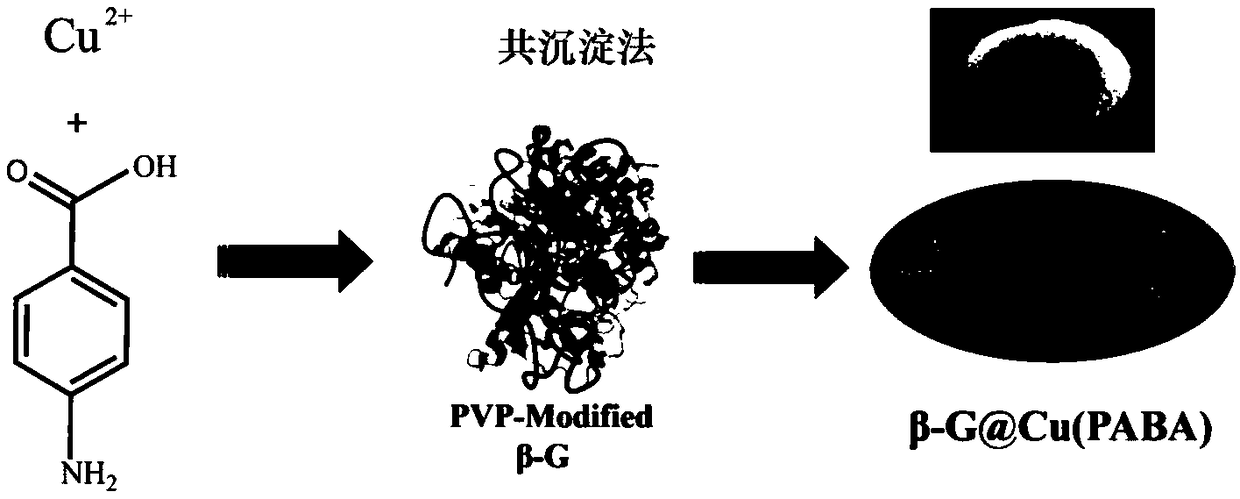Metal organic frame material immobilized beta-glucosidase and preparation method and application thereof
A metal-organic framework, glucosidase technology, applied in biochemical equipment and methods, immobilized on/in organic carriers, glycosylase, etc., can solve the problem of affecting enzyme catalytic activity and weak binding force of surface adsorption , the problem of high preparation cost, to achieve the effect of improving the recycling rate, optimizing the immobilization conditions, and improving the stability
- Summary
- Abstract
- Description
- Claims
- Application Information
AI Technical Summary
Problems solved by technology
Method used
Image
Examples
Embodiment 1
[0063] Example 1: Preparation of metal organic framework material (Cu(PABA)) and its immobilized enzyme β-G@Cu(PABA)
[0064] Weigh 50 µL of β-glucosidase, mix with 50 µL of polyvinyl pyrrolidone (PVP) solution, mix it with 50 mM copper acetate solution, and then add 12.5 mM PABA solution to fully mix. Incubate statically in a constant temperature shaking incubator at 25°C for 8 hours, centrifuge at 4°C after the reaction is completed, and store the product in a refrigerator at 4°C after repeated washing for 3 times, and obtain metal organic framework materials (Cu(PABA)) and It immobilizes the enzyme β-G@Cu(PABA).
Embodiment 2
[0065] Example 2: Characterization of metal-organic framework material (Cu(PABA)) and its immobilized enzyme β-G@Cu(PABA)
[0066] (1) Analysis of Fourier Transform Infrared Spectroscopy (FTIR)
[0067] The molecular structures of free β-glucosidase, metal-organic framework material Cu(PABA) and immobilized enzyme β-G@Cu(PABA) were detected by Fourier transform infrared spectrometer. First, KBr was dried overnight in an oven at 90 °C, and the treated sample and KBr were mixed at an equivalent ratio of 1:100, ground and pressed into tablets. Taking a separate KBr thin section as a blank, measure the infrared spectrograms of these three samples respectively, and record the infrared spectrograms of these three samples, such as figure 2 shown.
[0068] The metal-organic framework material (Cu(PABA)) and the immobilized enzyme β-G@Cu(PABA) were successfully synthesized by examining the positions of the characteristic group absorption peaks in the infrared spectrum and their shif...
Embodiment 3
[0081] Embodiment 3: The immobilization condition optimization of β-glucosidase
[0082] (1) Effect of metal ion and organic acid concentration on immobilization
[0083] The premise of the synthesis of immobilized enzyme β-G@Cu(PABA) is to be able to form the metal-organic framework material Cu(PABA). The corresponding concentration of copper acetate and p-aminobenzoic acid (PABA), as shown in Table 1 and Table 2, when the concentration of PABA is 6.25 mM, with the increase of copper acetate concentration, β-G@Cu(PABA) The immobilized amount and retained enzyme activity of the acid were slightly increased, because when the acid concentration was low, the amount of β-G@Cu(PABA) produced was less, and the free enzyme was introduced into the skeleton channel less. When the concentration of PABA was 12.5 mM, both immobilized capacity and retained enzyme activity were greatly increased, and when Cu 2+ When the concentration reaches 50 mM, the maximum immobilization capacity of β...
PUM
 Login to View More
Login to View More Abstract
Description
Claims
Application Information
 Login to View More
Login to View More - R&D
- Intellectual Property
- Life Sciences
- Materials
- Tech Scout
- Unparalleled Data Quality
- Higher Quality Content
- 60% Fewer Hallucinations
Browse by: Latest US Patents, China's latest patents, Technical Efficacy Thesaurus, Application Domain, Technology Topic, Popular Technical Reports.
© 2025 PatSnap. All rights reserved.Legal|Privacy policy|Modern Slavery Act Transparency Statement|Sitemap|About US| Contact US: help@patsnap.com



